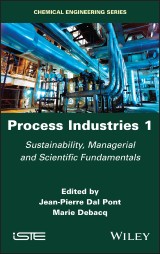Details

Process Industries 1
Sustainability, Managerial and Scientific Fundamentals1. Aufl.
|
139,99 € |
|
| Verlag: | Wiley |
| Format: | |
| Veröffentl.: | 08.10.2020 |
| ISBN/EAN: | 9781119779865 |
| Sprache: | englisch |
| Anzahl Seiten: | 272 |
DRM-geschütztes eBook, Sie benötigen z.B. Adobe Digital Editions und eine Adobe ID zum Lesen.
Beschreibungen
Of crucial economic and societal importance, process industries transform matter by chemical, physical or biological means. They cover broad fields such as chemistry, oil, pharmacy, metallurgy and agri-food, to name a few. As a result of knowledge exchange between the academic and industrial worlds, Process Industries 1 decrypts the operations and technical management of these industries in order to formulate and manufacture products with use-value, in a sustainable way. Using concrete examples, this book presents the fundamentals for defining the reaction and purification conditions that form the basis of chemical engineering. The unit operations – the technological building blocks of the production units – are the subject of scientific and technical descriptions supplemented by numerous videos. Frameworks, written by well-known specialists, provide a deep understanding of topics related to these themes. Process Industries 1 is intended for students, teachers, professionals and decision-makers interested in learning more about these industries.
<p>Foreword 1 ix<br /><i>Laurent BASEILHAC</i></p> <p>Foreword 2 xi<br /><i>Vincent LAFLÈCHE</i></p> <p>Foreword 3 xv<br /><i>June C. WISPELWEY</i></p> <p>Introduction xvii<br /><i>Jean-Pierre DAL PONT and Marie DEBACQ</i></p> <p><b>Chapter 1. Industries, Businesses and People </b><b>1<br /></b><i>Jean-Pierre DAL PONT</i></p> <p>1.1. Manufacturing, process, and service industries 2</p> <p>1.1.1. Manufacturing industries 2</p> <p>1.1.2. Process industries 2</p> <p>1.1.3. Service industries 3</p> <p>1.2. Founding fathers of the industrial enterprise 3</p> <p>1.3. Anatomy of an industrial enterprise 4</p> <p>1.4. Industrial strategy: the business plan 6</p> <p>1.4.1. Industrial strategy of the company 7</p> <p>1.4.2. Business plan 10</p> <p>1.4.3. Reengineering the corporation 11</p> <p>1.5. Systemic vision of the enterprise: the enterprise and flows 11</p> <p>1.6. The two operating modes of the enterprise: operational and entrepreneurial 13</p> <p>1.7. Governance 14</p> <p>1.8. Operations abroad 15</p> <p>1.9. References 15</p> <p><b>Chapter 2. Earth, Our Habitat: Products by the Millions, the Need for Awareness</b><b> 17<br /></b><i>Jean-Pierre DAL PONT and Michel ROYER</i></p> <p>2.1. Population explosion 18</p> <p>2.2. Systemic analysis and the concept of a system 20</p> <p>2.3. Earth, a complex system 22</p> <p>2.3.1. Atmospheric chemistry, ozone, and climate change 22</p> <p>2.3.2. Water-energy-food-climate nexus 22</p> <p>2.4. Awareness, sustainable development 26</p> <p>2.4.1. Rachel Carson and sustainability 26</p> <p>2.4.2. Sustainable development 27</p> <p>2.5. Products by the millions 28</p> <p>2.6. Resource Earth, garbage Earth: towards a circular economy 31</p> <p>2.6.1. Circular economy 32</p> <p>2.6.2. Lifecycle assessment (LCA) and ecodesign 33</p> <p>2.7. Materials science 34</p> <p>2.8. Product formulation and engineering 35</p> <p>2.9. Product toxicology and ecotoxicology 36</p> <p>2.10. Product packaging and ergonomics 37</p> <p>2.10.1. Packaging and packing/wrapping 37</p> <p>2.10.2. Ergonomics 37</p> <p>2.11. New consumer requirements 38</p> <p>2.12. Boxes 39</p> <p>2.13. References 83</p> <p><b>Chapter 3. Designing Chemical Products</b><b> 85<br /></b><i>Willi MEIER</i></p> <p>3.1. Introduction 85</p> <p>3.1.1. Why is chemical product design important? 85</p> <p>3.1.2. Current state of the art 87</p> <p>3.2. Basic technologies 88</p> <p>3.2.1. Dimensions 88</p> <p>3.2.2. Additives 89</p> <p>3.2.3. Microencapsulation 94</p> <p>3.3. Products 97</p> <p>3.3.1. Aspirin® 97</p> <p>3.3.2. Coffee and related beverages 99</p> <p>3.4. Product design 4.0 103</p> <p>3.5. References 105</p> <p><b>Chapter 4. Chemical Engineering: Introduction and Fundamentals</b><b> 107<br /></b><i>Marie DEBACQ, Alain GAUNAND and Céline HOURIEZ</i></p> <p>4.1. Introduction: definitions, history, and challenges 107</p> <p>4.1.1. Prehistory of chemical engineering 108</p> <p>4.1.2. A crosscutting science serving society 109</p> <p>4.1.3. Chemistry, formulation, industrial chemistry, chemical engineering, and product engineering 110</p> <p>4.2. Fundamentals of chemical engineering 114</p> <p>4.2.1. Thermodynamic fundamentals of chemical engineering 114</p> <p>4.2.2. Kinetic fundamentals of process design 126</p> <p>4.2.3. System-balances-performance approach for process design 145</p> <p>4.2.4. Conclusion: ideal hydrodynamics and balances 152</p> <p>4.3. Box 154</p> <p>4.4. References 155</p> <p><b>Chapter 5. Chemical Engineering: Unit Operations</b><b> 157<br /></b><i>Marie DEBACQ</i></p> <p>5.1. Distillation 159</p> <p>5.1.1. Vapor–liquid equilibria 162</p> <p>5.1.2. Balances for a distillation column 164</p> <p>5.1.3. McCabe–Thiele method 165</p> <p>5.1.4. Technologies for continuous distillation 167</p> <p>5.1.5. Conclusion on distillation 168</p> <p>5.2. Fluid–solid mechanical separations 169</p> <p>5.2.1. Fluid–solid interaction laws 169</p> <p>5.2.2. Settling 173</p> <p>5.2.3. Centrifugal and inertial separation 174</p> <p>5.2.4. Filtration 177</p> <p>5.2.5. Conclusion on fluid–solid mechanical separations 182</p> <p>5.3. Stirring 183</p> <p>5.3.1. Qualitative aspects of stirring 184</p> <p>5.3.2. Quantitative aspects of stirring 186</p> <p>5.3.3. Choice of impellers 188</p> <p>5.3.4. Stirred tank scale-up 189</p> <p>5.3.5. Conclusion on stirring 190</p> <p>5.4. Heat exchangers 190</p> <p>5.4.1. Heat exchanger technologies 190</p> <p>5.4.2. Designing heat exchangers 192</p> <p>5.4.3. Conclusion on heat exchangers 195</p> <p>5.5. Reactors 195</p> <p>5.5.1. Conversion rate and generalized extent of reaction 196</p> <p>5.5.2. Ideal homogeneous reactors 198</p> <p>5.5.3. Non-ideal reactors 203</p> <p>5.5.4. Multi-phase reactors 205</p> <p>5.6. Conclusion 208</p> <p>5.7. Boxes 209</p> <p>5.8. Glossary 223</p> <p>5.9. References 224</p> <p>List of Authors 227</p> <p>Index 229</p> <p>Summary of Volume 2 231</p>
<p><b>Jean-Pierre Dal Pont</b> is the president of the Société des Experts Chimistes de France (SECF). Specializing in process industries, he has been an industrial director in the United States and Asia-Pacific for many years.</p> <p><b>Marie Debacq</b> is responsible for the AgroParisTech technology platform in France. She was a research lecturer at Cnam (Paris), where her work involved experimental study and modeling of polyphasic reactors.</p>


















